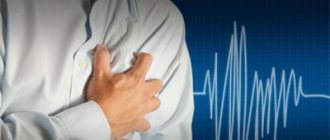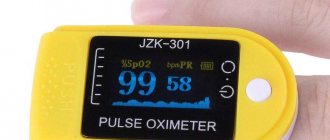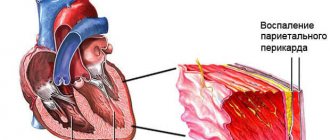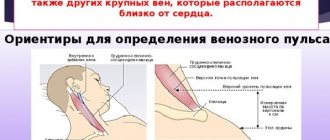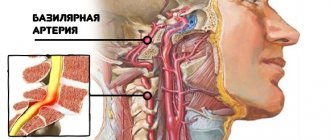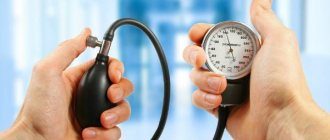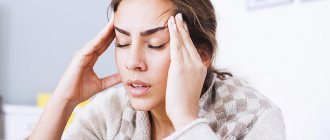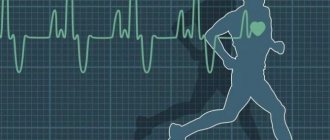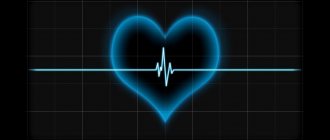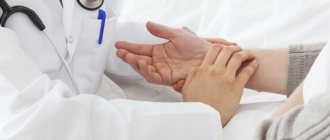Pulse is the rhythmic movement of blood through the veins as a result of myocardial contractions and pressure during one cardiac cycle. In medicine, the norm for a healthy person is considered to be 60-90 beats/minute. Only medical workers measure the pulse and give a verdict on abnormalities. They find out the causes of this pathology and give recommendations on how to increase your heart rate.
It is generally accepted that each age will have its own normal indicators:
- in newborns - 100-150 beats per minute;
- children (after 10 years) and adults 60-100;
- for athletes – 40-60.
A reduced heart rate is established after several measurements and is designated by the term bradycardia.
You can measure your heart rate using modern devices or using points on your body. They are located on the wrist, at the temple, on the bend of the elbow and knees, in the groin and on the neck in the area of the carotid arteries.
Causes of low heart rate
Bradycardia for no apparent reason is the most dangerous condition.
In this case, the therapist or pediatrician prescribes tests, in-depth diagnostics (ECG) and consultations with a cardiologist. Reasons for low heart rate may include:
- changes in the heart associated with aging;
- stressful frequent or prolonged conditions;
- disruption of the endocrine system (hypothyroidism);
- arterial hypertension;
- electrolyte imbalance in the body;
- accumulation of iron in the body (hemochromatosis);
- intoxication;
- vascular atherosclerosis;
- cardiac ischemia;
- contracting infections;
- increased performance;
- vegetative-vascular dystonia;
- myocarditis;
- heart defects;
- cardiosclerosis after a heart attack;
- taking medications and dietary supplements.
Cases when a person has a low pulse, but at the same time he feels good and does not complain about his health, are called physiological. Treatment is not required, especially if examinations have been carried out for heart pathologies and none were found.
Physiological bradycardia is especially often observed in athletes, being a sign of high endurance of their cardiovascular system.
What do the manifestations indicate?
With such disorders, there is often no deterioration in well-being. This is possible if low heart rates are presented as a physiological feature of the human body.
Manifestations of bradycardia occur if it is associated with pathologies of the heart and other organs. The clinical picture may be different for all patients.
Weakness
First of all, a decrease in heart rate is accompanied by a feeling of weakness. This is due to a decrease in blood pressure in the arteries. With such a manifestation, the presence of pathologies of the cardiovascular system is suspected.
When the pulse is low, the blood supply to the brain is disrupted. Such a clinical picture can be detected by dizziness, weakness and fainting conditions.
If the patient suffers from muscle dysfunction of the limbs, this is often associated with increased thyroid function.
In such cases, patients complain of increased nervous excitability, the development of insomnia, weight loss, trembling fingers and other signs.
The presence of general peace may indicate the development of illnesses of infectious origin.
If there is a slow increase in weakness with rare contractions of the heart, organ disease is suspected. Symptoms worsen during physical activity. The patient suffers from swelling, shortness of breath, and pain in the chest.
Arrhythmia
Why a low pulse is combined with arrhythmia is a question asked by everyone who has encountered similar problems. This clinical picture indicates heart pathologies. Most often, rhythm disturbance is a secondary disease, which is caused by malfunctions of the myocardium.
Bradycardia in combination with arrhythmia poses a serious health hazard. These manifestations may indicate:
- dysfunction of the thyroid gland;
- heart failure;
- insufficient amount of potassium in the blood;
- congenital defects.
The condition can be normalized only by eliminating the disease that caused the arrhythmia.
Lower heart rate in the morning
A decrease in heart rate does not always indicate pathological processes in the body. If the heart contracts slowly in the morning, this is normal, since during rest all processes in the body slow down.
In the morning hours, the heart beats about 60 times per minute. But the frequency of its contractions per day is constantly changing. Toward evening there is also a slowdown in indicators.
If there are no additional symptoms, then there is no cause for concern.
The presence of a low pulse in the morning is observed in people suffering from hypotension, chronic diseases and those who have suffered skull injuries.
After a heart attack
Rare heartbeats are considered normal if a person has had a heart attack. When the pulse drops to 50 beats, bradycardia and hypotension develop.
Also read: If the heartbeat goes to the throat
Such problems indicate a circulatory disorder and require urgent medical intervention.
Low temperature
Body temperature drops below the permissible limit if:
- the thyroid gland is not working properly;
- there is not enough hemoglobin in the body;
- the person suffers from chronic pathologies and a period of exacerbation has begun;
- the functioning of the adrenal glands is disrupted;
- there is a deficiency of vitamin C;
- There is a decrease in the functions of the immune system during pregnancy.
If, in addition to low temperature and bradycardia, tremors in the body, drowsiness and loss of coordination of movements are observed, this indicates parasite damage, diabetes, low sugar levels, anemia and other problems.
Headache
If an insufficient heart rate is combined with low blood pressure, a person suffers from headaches, weakness and general malaise. The pain can be dull and disturbing constantly or throbbing, which occurs in attacks.
Similar phenomena are observed during nervous or mental overstrain.
Dizziness
Dizziness is often associated with disruption of blood flow in the vessels, which can occur with arrhythmias. Such problems are dangerous for sudden death.
The patient suffers from such manifestations:
- in case of increased production of thyroid hormones;
- if a person eats little, is hypothermic or severely exhausted;
- with vegetative-vascular dystonia and hypotension;
- while taking certain medications.
The exact cause can only be determined during an examination.
Low pressure
Some people observe that when the pressure decreases, the heartbeat also slows down. These symptoms are accompanied by bradycardia. The problem may be related to:
- sudden hypothermia;
- defects, myocarditis, angina pectoris;
- excessive use of certain drugs;
- infectious processes;
- exhaustion, due to insufficient supply of useful components to the body;
- neck and chest injuries;
- poisoning with toxic substances.
If the disease that caused the decrease in blood pressure is eliminated, the condition is restored.
Normal pressure
Even if your blood pressure is fine, your heart may beat more slowly. In the absence of any deterioration in health, the patient should not be nervous. A slow heart rate is acceptable in some cases. For example, if a person has been involved in sports for a long time. In this case, the heart and blood vessels are well trained, so even with a slow pulse, the condition does not worsen and the body functions correctly.
If your health deteriorates, you should undergo an examination.
If a person suffers from bradycardia, then he has a low pulse in combination with normal blood pressure. With this rhythm disturbance, irreversible damage to the heart muscle is most often observed, caused by defects, myocarditis, and ischemic disorders.
The development of bradycardia is possible when swimming in cold water, excessive use of beta blockers, quinidine, cardiac glycosides.
It is important to remember that the development of bradycardia at normal pressure increases the likelihood of developing arrhythmic collapse, in which most patients die.
Causes of decreased heart rate
Pulse is an indicator that shows the frequency of heart contractions per minute. Using this parameter, you can judge the state of human health. If it deviates greatly from the norm, this indicates the emergence of serious pathologies.
The norm is considered to be 60-90 beats per minute against the background of normal pressure readings. This is true for healthy adults. Higher rates are typical for children and older people.
Bradycardia is a condition in which the heart rate is less than 60 beats per minute. With this pathology, the parameters are usually 50-55 beats.
Important: To make an accurate diagnosis, this condition must be present continuously over a long period of time. A single decrease in heart rate cannot be called a pathology if there are no other symptoms
Pathologies of the heart, blood vessels and endocrine system lead to the development of bradycardia. A low heart rate is also observed for the following reasons:
- Intoxication, poisoning with harmful substances. In such a situation, in addition to bradycardia, there are noticeable symptoms of poisoning of the body.
- Increased physical or emotional stress. In this case, tachycardia is often observed. However, the pulsation may decrease. It all depends on the individual characteristics of the body.
- Sensitivity to weather conditions. Some people experience bradycardia when the weather changes. In such a situation, increased fatigue and pressure fluctuations may occur.
- Taking certain medications.
A slight bradycardia is considered normal for some people who play sports professionally. This is due to the body becoming accustomed to increased stress on the heart and blood vessels.
In addition, it is worth considering that some people initially have a pulse below normal. This indicates individual characteristics. In this case, there are no manifestations of pathology or malaise. In such a situation, there is no need to artificially increase the heart rate.
Cardiac causes
The moments of development are multiple; just listing them would take at least several volumes. The most common heart diseases:
Previous heart attack
Acute necrosis ends with a temporary drop in the functional activity of cardiac structures.
A small pulse (at the level of 50-55 beats per minute) is a normal phenomenon associated with restructuring in a new way, adaptation, and tissue sclerosis. Recovery of heart rate occurs after 6-8 months.
Sick sinus syndrome
Disruption of the activity of a special cluster of cells called the pacemaker. Why the deviation occurs is not known exactly. But the strength of the bioelectric impulse decreases.
The sinoatrial structure is not able to produce a signal with sufficient frequency and strength, the heartbeat becomes low, but the pressure remains within normal limits. Read more about the disease in this article. Bradycardia, especially persistent, is the first sign of myocardial conduction disturbance.
Cardiac blocks
Most often, individual bundle branches (right or left) or the atrioventricular node are affected. In the latter case, they talk about AV block, which is deadly.
Violation of the movement of the impulse along the His bundles leads to a partial deviation (compensation is quite fast).
Failure to conduct through the AV node results in cardiac arrest.
The impulse does not reach the ventricles and circulates in the atria. The lower chambers are forced to spontaneously excite. Chaotic abbreviations have no functional meaning. Bradycardia with fibrillation occurs, and then the death of the patient.
Myocarditis
Inflammation of the heart muscle, a common complication of angina. Usually manifests as tachycardia. But when a significant amount of tissue is involved in the pathological process, the opposite is true.
This is a negative diagnostic sign. Treatment is always inpatient, with the use of antibiotics (infectious form) or immunosuppressants. Rheumatism is partly associated with myocarditis.
Cardiac tamponade
An emergency condition associated with compression of an organ by fluid or blood from the external environment. It is extremely dangerous, leading to asystole and death without proper therapy. Read more about tamponade and hemotamponade here.
How to raise your heart rate at home
How to increase your heart rate at home? You can use the following methods:
- If the cause of low pulse is hypertension, cardiac neurosis, or nervous disorders, Corvalol will be effective. The drug increases heart rate, eliminates neurosis-like conditions, sleep disorders associated with stress, anxiety and agitation. The above-described effects of this drug develop very quickly and last for eight hours. The dosage is from 15 to 30 drops before meals in the morning, lunch and evening. In case of overdose, the drug has a hypnotic effect.
- Physical activity will help raise your heart rate. People with a low heart rate are recommended to go swimming, light jogging, spend more time in the air, and take hot baths.
- You can raise your heart rate when you have pain in the heart by massaging your earlobes for several minutes.
- If the pulse is less than 40–50 beats per minute, then tonic drinks containing caffeine, strong tea, ginseng preparations, Eleutherococcus, rosea radiola, guarana or belladonna will help increase blood pressure. They increase the heart rate very quickly: this requires no more than 3-5 minutes. The mechanism of action of such drugs after their use is a spasm of the body’s blood vessels, which increases blood pressure and, accordingly, the pulse. For the effect to be noticeable, medicinal herbs are taken for at least three months. However, it should be noted that such drugs are not recommended for use in hypertension, as they can provoke a hypertensive crisis.
- Another way to raise a low heart rate is to use mustard plaster. It is applied to a part of the body located just to the right of the heart. The optimal time for such a procedure is no more than three minutes. It is not recommended to carry out manipulation very often, as this can lead to undesirable consequences.
Drinking a moderate amount of wine helps prevent heart disease. This drink helps normalize heart rhythm, dilate blood vessels, and stabilize blood pressure. To prepare a remedy that will help raise your pulse, you should boil one liter of red wine. Then add 15 grams of honey, the same amount of cumin seeds and cinnamon. The product is taken warm, 50 ml daily. It should be noted that you cannot take medications along with this procedure.
Lemons will help normalize the pulse: 10 pieces should be poured with boiling water and in this state they should lie for a minute. Then the juice from each lemon is squeezed out. Take ten heads of garlic and grind them to a paste. Garlic will be crushed better if you add a small amount of lemon juice to it. Now you should place a liter of honey and garlic mixed with lemon juice in a three-liter jar. The resulting mixture should be mixed and placed in a cool place where there is no access to sunlight, but not in the refrigerator.
The product is infused for ten days, and the container must be shaken every day. To take the medicine, it should be poured into a smaller container and shaken each time before use. Take 20 grams once a day 30 minutes before meals (preferably taken on an empty stomach in the morning). Divide the indicated volume into 4 teaspoons, the first spoon should be dissolved over 60 seconds, the rest - with a break of 60 seconds. The treatment course is three months. After a year, if necessary, treatment can be repeated.
For nut lovers, there is a remedy that will help raise your pulse: half a kilogram of walnut kernels should be crushed using a blender. 300 ml of sesame oil and 300 grams of sugar are added to them. The resulting mixture should be mixed, then 4 lemons along with the zest are cut into a deep plate. Sliced lemons are poured with boiling water. Add this lemon mixture to the prepared nut mixture. The drug is taken 15 grams three times a day before meals.
Radish juice and honey mixed in equal proportions will help increase your heart rate. The medicine is taken 15 grams three times a day before meals.
Treatment
If bradycardia is provoked by taking certain medications, they are canceled. In case of overwork, the patient needs proper sleep and rest. If a weak pulse is associated with a disturbance in the circulatory system, ginseng and eleutherococcus extract, Isoprenaline, Ephedrine and Caffeine are prescribed. Treatment can also be carried out with such drugs as Atropine sulfate, Isandrine, Ipratropium bromide, Ephedrine hydrochloride.
It is prohibited to prescribe medications yourself!
Increasing the pulse with herbs is approved by most doctors, despite their skepticism regarding non-traditional treatment methods. Many plants contain components that can activate the body's hidden reserves.
As a result, the immune system is strengthened, blood circulation is normalized and the heart muscle works at a normal pace. Herbs rarely have contraindications and side effects, which is another plus. The exception is individual hypersensitivity and a tendency to allergies.
Traditional healers know how to increase the number of heartbeats. They recommend the following recipes:
- A decoction based on burdock root. The raw materials are crushed and poured with boiling water. 2 tablespoons of crushed root per half liter of water is enough. Take 50 g three times a day.
- Black elderberry flowers are poured with boiling water. Infuse for at least two hours, drink two glasses a day.
- Alcohol tincture with nuts and sugar. 0.5 kg of walnut skins are poured into 1 liter of alcohol and lemon juice is added. Drink 20 drops before meals three times a day.
To really help your body at home, strictly follow the dosage and do not get carried away with self-medication. If there is no effect from alternative treatment for two weeks, contact a therapist or cardiologist.
How to raise your heart rate at home
Everyone at risk should be informed about how to raise their heart rate at home. Methods for increasing heart rate depend on the individual health of the patient and his blood pressure.
For hypertension and neuroses, Corvalol tincture will help increase your pulse rate. Its additional benefit is the elimination of anxiety and sleep disturbances.
The dosage of the tincture is as follows: 15-30 drops three times a day before meals. It can be taken by the elderly, men and women.
The following techniques help increase your heart rate when readings are below normal:
- physical activity - swimming, running, walking in the fresh air;
- taking a hot bath;
- quick massage of the earlobe.
At normal pressure
You can increase a low heart rate with normal blood pressure by jogging and physical exercises:
- raise your hands up, freeze for a couple of seconds, then lower them sharply;
- lie on the floor, twist your legs in a circle and sideways 20 times;
- lying on the floor, bend your legs, clasp your arms, making efforts, try to separate your hands with pressing movements of your knees;
- clench and unclench your left hand.
There are many options for raising your heart rate at home, from taking herbs to special medications. Natural remedies sold in pharmacies or prepared independently will help eliminate the ailment.
Remember that it is better not to self-medicate; you should first get approval from your doctor. How to increase your heart rate to normal: take medications according to the instructions and advice of a doctor, give up alcohol and smoking, get more rest, experience calm emotions and switch to a healthy diet, limiting the intake of animal fats and sweets.
Drugs for bradycardia
In a person who has no serious pathologies, the number of heart contractions can be increased using folk remedies. To do this, just drink a cup of strong green or black tea. If possible, add a slice of fresh lemon.
Important! To quickly normalize your heart rate, you should give up alcohol and smoking. . There are a large number of medications that will help you do this, but you need to remember that you don’t need to take the first remedy you come across.
It must be prescribed to you by a doctor.
There are a large number of medications that will help do this, but you need to remember that you don’t need to take the first remedy you come across. It must be prescribed to you by a doctor.
In alternative medicine there is also a fairly large number of different recipes. Traditional healers advise taking herbs for heart tachycardia and rhythm disturbances.
Everyone at risk should be informed about how to raise their heart rate at home. Methods for increasing heart rate depend on the individual health of the patient and his blood pressure.
For hypertension and neuroses, Corvalol tincture will help increase your pulse rate. Its additional benefit is the elimination of anxiety and sleep disturbances.
The dosage of the tincture is as follows: 15-30 drops three times a day before meals. It can be taken by the elderly, men and women.
There are many options for raising your heart rate at home, from taking herbs to special medications. Natural remedies sold in pharmacies or prepared independently will help eliminate the ailment.
Therapy methods
Therapeutic tactics depend on the underlying disease that caused the low pulse while maintaining normal blood pressure.
- Cardiac pathologies themselves are treated with medication. The operation is indicated for defects, atherosclerosis and malnutrition of the heart tissue. Drugs are selected with caution, tonic medications are prescribed.
- Endocrine abnormalities require replacement therapy or surgery (for tumors, etc.).
- Neurogenic factors are eliminated with sedatives based on herbal components. Like Motherwort. Valerian and others.
- Symptomatic therapy - prescribing Eleutherococcus tincture, Ginseng, caffeine-based products. Critical heart rate levels are corrected by Epinephrine and Adrenaline.
After normalization and discharge from the hospital, or a visit to a specialist, lifestyle changes are recommended.
Correction of the diet, in accordance with treatment table No. 10, giving up alcohol, cigarettes and tobacco products in general.
Moderate physical activity at the level of walking, swimming. If drugs are the cause of bradycardia, you need to consult a doctor and adjust the main course of therapy.
Drug therapy
The approach to treating bradycardia is complex; part of it is taking a number of medications. When choosing a drug, it is necessary to take into account the reason that caused the appearance of a low pulse. If the patient has hormonal imbalance, the doctor will prescribe appropriate medications to normalize it. Before this, the patient will be prescribed a blood test from a vein and, possibly, other instrumental studies to correctly diagnose the disorder.
In the presence of neurological causes, primarily autonomic dysfunction syndrome, complex therapy uses drugs that reduce the activity of the vagus nerve, for example Amizil, Bellataminal.
Treatment methods for sinus bradycardia
Medicines that have a stimulating effect on the body have proven themselves well. These drugs belong to the group of adaptogens of plant, animal, mineral and synthetic origin. Herbal remedies include tincture of eleutherococcus, lemongrass, ginseng and rhodiola, and Zelenin drops. They are used internally in pure form or diluted in boiled water at room temperature.
The biogenic stimulant Apilak should not be ignored. It contains royal jelly - a special secretion produced by the glands of bees to feed their offspring. This is a very valuable product, rich in vitamins, microelements, enzymes, nucleic and fatty acids, which makes it almost indispensable for doctors and patients when deciding how to raise their pulse.
Apilak
Another worthy representative of the group of adaptogens is Mumiyo. The drug is available in the form of tablets, paste and rectal suppositories. The active substance is collected on an array of high-mountain rocks, then the product undergoes purification processes and other technological processes that bring it into the form necessary for the medicine.
Mumiyo has a powerful restorative, restorative and tonic effect on the body. The specific effect is due to the complex of biologically active substances of both organic and inorganic nature included in the composition.
Adaptogens should be used in courses, in the first half of the day.
It is important to adhere to the prescribed dosages and not exceed them in order to avoid sleep disturbances, tachycardia, headaches, increased blood pressure and allergic reactions.
You should not expect instant results from some drugs, since most of them have a cumulative effect.
Diagnostics
Conducted by a cardiologist. In the absence of data for a purely cardiac process, a neurologist may be involved.
Approximate list of events:
- Oral interview and history taking. Objectification of symptoms, drawing up a clinical picture.
- Measurement of blood pressure and heart rate. Blood pressure is normal, but heart rate drops. This is a typical but not required combination. The indicators exist separately.
- 24-hour Holter monitoring. Dynamic assessment of indicated vital levels over a 24-hour period. If necessary, it is prescribed repeatedly. It is considered the most informative methods of early diagnosis.
- Electrocardiography. Study of the functional activity of cardiac structures. Detects arrhythmias and other disorders.
- Echocardiography. Used to visualize defects and anatomical defects.
- MRI as needed
- EEG.
- Assessment of neurological status using routine methods. Including testing basic reflexes.
- General blood test, biochemical, hormones. In case of metabolic disorders or deviations in the level of specific substances, an endocrinologist is involved.
This is enough for early diagnosis.
Causes of low heart rate
External factors contributing to the occurrence of short-term bradycardia that does not require medical intervention:
- Sports activities (swimming, football, running, rowing, strength training). A low heart rate (45-50 beats/min) occurs in professional athletes and children involved in several sections simultaneously. In this case, attacks usually occur at night and are not accompanied by other symptoms. In the human heart muscle, additional fibers are formed due to the constant work of the organ in an enhanced mode. Therefore, the body adapts to this rhythm of life, ensuring the necessary blood circulation at a low heart rate.
- Hypothermia (prolonged exposure to cold water). This term refers to the complex cooling of the body to a temperature of less than 35 degrees. Bradycardia occurs as a defensive reaction. The heart begins to contract less to conserve energy. This state resembles suspended animation.
- Unintentional pressure on the eyeballs or compression of the vagus nerve in the area of the carotid artery with a tie causes stimulation of the reflex zone of the heart. The pulse decreases by about 10 beats/min.
Pathological causes of decreased heart rate:
- Taking medications (cardiac glycosides, beta blockers, morphine, amisulpride, adenosine) in excessive dosages or in the presence of individual intolerance to the components included in their composition. Improper use of drugs provokes the development of side effects or poisoning requiring medical attention.
- Age-related and acquired cardiosclerosis, in which islands of connective tissue appear in the myocardium. This leads to a deterioration in cardiac contractility.
- Hypothyroidism. Lack of thyroid hormones, which are involved in most vital processes occurring in the body. The doctor will determine this cause of bradycardia by the presence of accompanying symptoms. The attacks will appear more and more often, and then become permanent.
- Infectious diseases (viral hepatitis, typhoid fever, sepsis). There comes a time when the body cannot fight the infection and the functioning of the heart is disrupted, as indicated by a drop in blood pressure and the gradual development of dysfunction of various organs and systems. Often the pathology ends in the death of the patient.
- Heart diseases (myocardial infarction, endocarditis, myocarditis, ischemia). In this case, the tissue of the conduction system is damaged, which leads to untimely contraction of cardiomyocytes and a slowdown in the pulse. The symptom is not constant for this type of pathology, so additional diagnostics are prescribed.
- Increased tone of the parasympathetic nervous system due to neuroses, intracerebral hemorrhage, peptic ulcer, tumor in the mediastinum, injuries to the head, neck and chest. Such conditions lead to infringement of the vagus nerve.
- Poisoning with chemical elements (pesticides, lead, drugs, nicotine). Bradycardia develops very quickly, and the heart rate depends on the amount of toxin entering the blood.
- In addition to heart disease, against a background of high levels, it decreases with atherosclerosis and VSD, especially in elderly patients.
What are the symptoms
Only changes in health for the worse make us think that a resting heart rate of 45-49 beats per minute is not normal and requires treatment.
The main symptoms of low heart rate (bradycardia) are:
- Weakness and malaise. They arise due to insufficient enrichment of muscles with oxygen. A deficiency of tissue nutrition leads to a decrease in motor activity.
- Frequent dizziness. As a result of disruption of the heart, the brain is exposed to oxygen starvation, which contributes to attacks of vertigo. This usually happens when the heart rate drops to 47 beats per minute or below.
- Dyspnea. Occurs with bradycardia during exercise. Insufficient blood circulation creates problems with gas exchange in the lungs. The rhythm of breathing is disrupted and there is a lack of oxygen in the lungs, which leads to shortness of breath and a dry cough.
- Paleness of the skin. This is due to a decrease in blood pressure. When there is a shortage of blood supply, the body uses additional resources from everywhere. A pulse rate of 46 beats can already significantly reduce blood pressure and devastate the vascular network of the skin.
Bradycardia can manifest itself in various forms and have symptoms similar to other diseases. Erroneous self-diagnosis causes a lot of complications.
Important! If you have any symptoms of bradycardia, you should immediately consult a doctor.
Medicines to increase heart rate at normal blood pressure
It is not recommended to resort to treatment with pharmacological agents on your own; it is necessary to undergo a comprehensive examination by a cardiologist, who will prescribe treatment based on medical indications. Otherwise, you can increase the pressure along with the pulse, which in conditions of hypertension will lead to a hypertensive crisis with potentially dire consequences.
Some spices increase your heart rate without affecting your blood pressure. A pinch of cinnamon, cloves, and nutmeg will diversify the taste of the dish and help with bradycardia.
The following drugs are most often used clinically for bradycardia associated with hypertension:
- Tonic tinctures are prescribed to patients with chronic bradycardia without organic pathology. These drugs give a surge of strength and energy, make the heart beat faster and stronger, and improve blood circulation. These include tincture of ginseng, echinacea, and eleutherococcus. The dose should be less than the average therapeutic dose indicated in the leaflet - otherwise the blood pressure may rise.
- Caffeine is a psychostimulant, its mechanism of action is central, that is, the substance affects the brain, in particular, the medulla oblongata, where the vasomotor center is located. Its activation leads to an increase in heart rate, but the pressure can only increase indirectly. The use of Citramon or Coficil, or just a small cup of natural coffee can be effective.
- Drugs that improve cerebral circulation - nootropics that optimize brain metabolism, expand the lumen of cerebral vessels, and improve microcirculation in the thickness of tissues. These remedies help the main organ of the body cope with oxygen starvation without complications. The balance between the processes of activation and inhibition (activity of the sympathetic and parasympathetic nervous systems) brings the pulse back to normal. These are Piracetam, Cinnarizine, Phenotropil,
- Microelements - magnesium and potassium preparations normalize the functioning of the conduction system of the heart, help with arrhythmias and bradycardia. These ions are necessary for good conduction of nerve impulses in the heart and contraction of muscle fibers (contained in the preparations Cardiomagnyl, Aspecard).
- Cardiotonic medications are prescribed only in cases of severe heart failure and are available with a prescription. These are drugs that accumulate abundantly in the body, their effect lasts a long time, sometimes up to several days, so it is important to observe the dose and frequency of administration. These are Digoxin, Digitoxin, Dobutamine and others.
To increase your heart rate, it is useful to actively massage your earlobes - this improves microcirculation and reflexively leads to an increase in heart rate.
If your blood pressure increases along with your pulse after taking this or that drug, you should notify your doctor, who will adjust the therapy.
Folk recipes
Folk wisdom, tested over the years and generations, is also widely used:
- Tip 1 . Radish juice and honey help speed up your heart rate. To prepare the medicine, cut off the “lid” of the radish, make a depression in the pulp and fill one third with honey. The resulting syrup is divided into 3 doses.
- Tip 2 . For this method you will need to mix the juice of 10 lemons, 10 heads of garlic and 1 liter of honey. Take the product 4 tsp. on an empty stomach, slowly dissolving in the mouth.
- Tip 3 . Boil 10 pcs. rose hips in 0.5 liters of water (15 min). Grind the berries with 3 tsp. honey Take 100 g daily.
Ways to combat bradycardia
There are many proven ways to increase your heart rate at normal blood pressure. If the pressure is low or high, then you need to use more aggressive or, on the contrary, easier methods of home treatment.
The most common options for combating the disease include:
- Strong tea or coffee is one of the most effective and fastest options for raising your heart rate. It is best to use black tea and instant coffee. You can also add lemon and sugar to the drink. Don't forget about sweet mint tea;
- tincture based on hawthorn, St. John's wort, Rhodiola rosea root and rose hips . All components must be placed in a glass jar, filled with hot water and left for two hours. You need to use the tincture half a glass 3 times a day before meals;
- Light physical activity or exercise is the easiest way to increase your heart rate without increasing your blood pressure. Cycling or jogging for 10 minutes will help normalize your heart rate. Regular visits to the pool have a positive effect on the body;
- black chocolate . It has a tonic effect and normalizes heart rate. You can only use dark dark chocolate, since milk chocolate simply won’t help. 15 grams of chocolate is enough to raise your pulse to 70 beats per minute;
- alcohol tinctures . Products based on effective medicinal herbs are effective: Rhodiola, ginseng and Eleutherococcus. But here it is important to be careful, since taking these tinctures with high blood pressure is strictly prohibited;
- taurine or caffeine in tablet form . This is a way to increase blood pressure and pulse at the same time. You can purchase the drugs at any pharmacy. To normalize the pulse, it is enough to drink 1-2 tablets;
- lemon tinctures . Squeeze the juice from 10 lemons, then take the garlic pulp at a 1:1 ratio. All ingredients must be placed in a three-liter jar and filled with a liter. The mixture must be stirred well and left in a dark place for 11 days. You need to take 20 grams on an empty stomach, 40 minutes before meals for three months.
If a decrease in pulse is accompanied by periodic aching or squeezing pain in the heart area, massaging the earlobes for 10 minutes will help overcome unpleasant symptoms and normalize the pulse.
The effectiveness of combating bradycardia depends on whether a person is ready to give up his bad habits. A proper daily routine, a balanced diet, and quitting smoking and alcohol will help avoid a possible relapse of the disease.
How to increase your heart rate if bradycardia occurs
The first thing to do is check the heart rate readings to clarify the correct diagnosis. Then measure your blood pressure, since if your heart rate drops sharply, your blood pressure may also drop. If this is the case, then caffeine is recommended (medicines must be taken as prescribed by a doctor). You can eat a piece of chocolate, drink a mug of sweet tea or coffee.
Among the folk remedies, ginseng root will help increase your pulse. Recipe:
- To prepare the tincture, you need to take 25 g of dry crushed root, pour in 1 liter of vodka and let it brew for 20 days.
- The course of treatment is 2 months. Take 15 drops 20 minutes before meals.
Weak pulse: clinical picture
In order to promptly determine a slow pulse, as well as understand whether a slow pulse indicates exactly what disorders are occurring in the body, every person should know the main symptoms of this condition.
It is quite difficult to detect bradycardia at its very beginning, and visible signs appear when the consequences of this condition appear.
The clinical picture may be as follows:
- impaired human orientation in space;
- sudden loss of strength;
- pain in the temples and forehead;
- urge to vomit;
- increased fatigue;
- Frequent lightheadedness or fainting.
Over time, an insufficient pulse provokes the development of hypoxia (oxygen starvation of the brain). Accordingly, dysfunction of the brain, fatal arrhythmia, dysfunction of the sinus node.
Risk of decline due to pathology
If the rare pulse level is physiological, then there is absolutely no danger to human health as a whole. In this case, there are absolutely no manifestations or deterioration in the general condition. However, in the presence of any initial pathology, a person may complain of periodic dizziness or general weakness. In some cases, chest pain appears, absent-mindedness occurs, or even periodic memory loss.
Therefore, if there is a decrease in heart rate precisely due to the presence of cardiac pathologies, you should definitely seek advice from a cardiologist and undergo a full examination, including a cardiogram, daily ECG monitoring, and echocardiography.
Due to the occurrence of bradycardia, the blood supply to all organs and systems of the body is disrupted. This is especially dangerous when there is not enough nutrition for the brain.
If you notice a sudden reduction in the rhythm of your heart beats, do not waste time. You must call a doctor immediately. When the heart rate drops to thirty beats per minute, a person may suddenly lose consciousness. Therefore, before the ambulance arrives, it is necessary to put the patient to bed and apply cotton wool soaked in ammonia to the nose.
